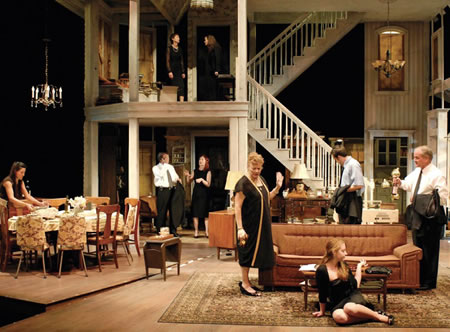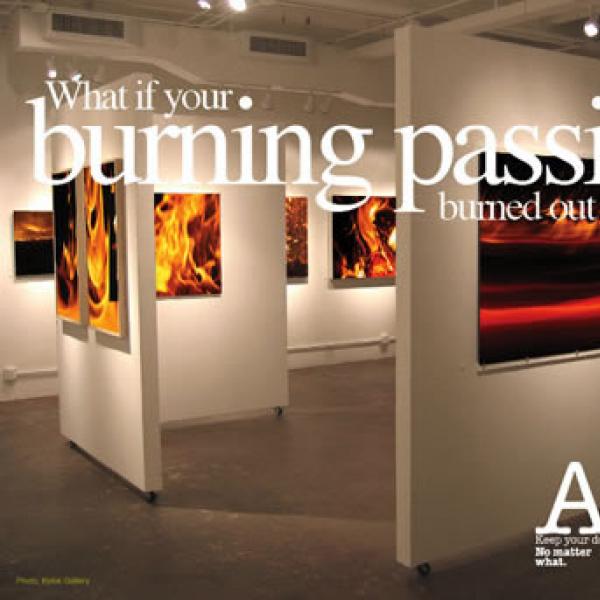Filling Their Souls

In 1974, a plucky group of young actors in suburban Illinois who rehearsed in a borrowed church basement decided, "Hey, let's start a theater company!" What may sound like the premise of a new TV show along the lines of Smash and Glee is, actually, a true story—starring Gary Sinise, Jeff Perry, and Terry Kinney as the plucky young actors. The theater they founded in that basement? Chicago's Tony Award-winning Steppenwolf Theatre Company (with a name borrowed from the Herman Hesse novel for no particular reason at all). The theater, which received the National Medal of Arts in 1998, is heading toward its 40th birthday, which is not bad considering that neither Sinise, Perry, nor Kinney knew that what they were incubating would become one of the most highly revered theaters in the world. In fact, according to Perry, they "had no other particular skill set" and were just doing what they loved. He added, "I don't remember thinking more than a week ahead…I don't think any of us did. I think we only thought to the next opening of the show."
|
NEA Arts article |
The initial trio of Sinise, Perry, and Kinney quickly expanded to include John Malkovich, Laurie Metcalf, and several others, all but two of whom are still with Steppenwolf. The troupe became known for challenging, gritty work with early productions such as Harold Pinter's The Lover, Samuel Beckett'sKrapp's Last Tape, and Clifford Odets' Waiting for Lefty. In its early years, Steppenwolf also inaugurated its tradition of premiering new plays. In 1978 Dan Ursini became the group's first resident playwright; his play Quiet Jeannie Green premiered the next season with ensemble member Joan Allen in the title role.
Even as the theater rose in acclaim, the process for joining the ensemble remained the same. Current ensemble members recommended people whose work they'd admired or who they'd worked with. If everyone agreed, an invitation was issued. As it grew, Steppenwolf hopscotched from the suburbs into Chicago proper, arriving at its current home in the city's Lincoln Park neighborhood in 1982. That same year Broadway came calling, and Sinise, Malkovich, Metcalf, and Francis Guinan took on audiences at New York's Cherry Lane Theatre in a production of Sam Shepard's True West, directed by Sinise. (The original Chicago version featured Perry onstage instead of Sinise.) Perry remembered that the show wasn't officially billed as a "Steppenwolf" production. But given the theater company's prominence on the cast's resumes it received the credit just the same, and a national reputation was born.

Laurie Metcalf and John Malkovich in True West by Sam Shepard, directed by Gary Sinise. Photo by Lisa Ebright |
After its Broadway run, the cast returned to Chicago and to Steppenwolf. This commitment to mark of the company, which now comprises 43 artists, including actors, playwrights, and directors. The sheer depth of talent in the members is staggering; the ensemble counts numerous Tony Awards (including a 1985 Tony for Regional Theater Excellence), Pulitzer Prizes, and other awards among its many honors. Some members—such as Allen, Metcalf, Malkovich, and Sinise—have become household names from their work in TV and film. Others have made names for themselves primarily on the stage, such as playwrights Tarell Alvin McCraney and Tracy Letts, and directors Frank Galati and Anna D. Shapiro. What they all have in common, according to McCraney, who joined the ensemble in 2010, is a deep desire for a place to call home.
|
Audio blog the Tarrell Alvin McCraney |
"The life of an artist solely in the theater—you might be able to make a living, but you certainly won't make a killing, as they say. So actors have to go off, and writers have to go off, and directors have to go off and find other ways to support themselves," McCraney commented. "But the great thing about Steppenwolf is that you keep coming back to do quality work and I think that's one of the major reasons people keep coming back. They can do quality work and fill their soul and then be aglow, be awash for awhile as you have to do other things that you may not love so much."
Steppenwolf's current artistic director, Martha Lavey, joined the ensemble as an actor in 1993, becoming the company's artistic director two years later. Lavey explained that the ensemble is about more than being a name on the list; the members really are the engine that drives which projects Steppenwolf takes on. "Season planning is a two-way conversation between the artistic office and the ensemble, and I'm a pivot point for that," she said. For example, Galati, who worked on the Broadway adaptation of E.L. Doctorow's Ragtime, became interested in Doctorow's The March. He brought the idea to Lavey, they eventually obtained the rights to the work, and the show is part of this year's mainstage season.
Steppenwolf, like many of its peers, is taking a hard look at how it interacts with its community as well. "In those early days they were thinking about what they wanted to do artistically, what served them individually as artists, and what the life and character of the ensemble was," said Lavey, who employed the metaphor of a conversation to trace the evolution of Steppenwolf's relationship with its audience. If the theater's early years were a conversation among artists, today the conversation is a two-way dialogue between Steppenwolf and its community.

The Steppenwolf cast of August: Osage County, written by theater company member Tracy Letts and winner of the 2008 Pulitzer Prize in Drama. Photo by Michael Brosilow |
The Young Adults Council is one testament to Steppenwolf's new approach to community engagement. Founded in 2007, the council—one of numerous Steppenwolf outreach programs targeted to diverse populations—is a leadership education program comprising roughly 30 teens from across the Chicago metro area. The high-schoolers must pass muster on an essay-based application before joining the select group that meets once a week for nine months to learn the ins and outs of professional theater from the ensemble and other local theater artists. For McCraney, the Young Adults Council is one of Steppenwolf's most impressive features. "Those young people are amazing," he enthused. "They're diverse, they're energetic, they're intelligent, they're active…. You look at them and think, 'Oh, they'll be running this place in about ten years.' And it's encouraging [and] exciting."
In 2010, Steppenwolf—mindful of its own roots in that church basement—debuted its Garage Rep program, which invites what its website calls "Chicago storefront theaters" to take up a repertory-style residency in one of the theater's smaller spaces. While Steppenwolf had early on established a tradition of hosting visiting companies, Lavey—with a grant in hand from the Doris Duke Foundation—felt the theater needed to make it easier for emerging companies to participate. "I was looking at the model for a visiting company, and I thought, 'You know, the financial imperative for the visiting company, it still requires a certain amount of institutional infrastructure for companies to come in. Is there a way we can create a template for producing these companies that allows us to reach a younger or newer group of theater companies?'" The new model places less financial demand on the visitors, while still allowing them to have a larger footprint in terms of visibility and reach. The young artists also gain access to a community of mentors.
Today Steppenwolf's influence extends far beyond its humble beginnings in Highland Park. In addition to touring productions domestically—to Washington, DC and Los Angeles, for example—the company has also brought work to the Galway Arts Festival in Ireland, the Barbican Centre in London, and the Melbourne Festival in Australia. Yet, it has no intention of getting too comfortable with its reputation and still looks to break new ground. In 2009 it produced its first Shakespeare play, The Tempest, directed by Tina Landau and featuring a number of ensemble members. Last year saw the launch of yet another new project: the NEXT UP festival, a collaboration with Northwestern University featuring directors and designers from the school's graduate theater program.
"I think Steppenwolf has really gotten itself into a situation," said McCraney, looking at all the current activities of the theater company, "where it's reaching out to the future and paying homage to the past and living very much in the present."










